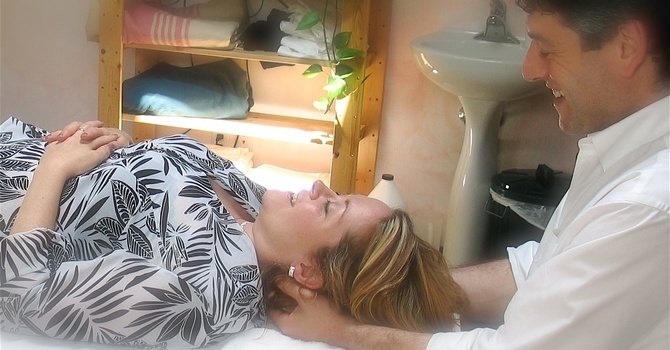Colic. Your beautiful baby screams incessantly, fists clenched, rigid body, obviously in pain. You try rocking, singing, gripe water, perhaps changing your diet or the baby’s.
As an otherwise capable parent, you may reduced by sleep deprivation and tension to feelings of failure, panic and tears. Post partum depression may be triggered or worsened by the stress of a high needs baby. A mother experiencing a post partum mood disorder may feel unable to cope. Parents are often at the breaking point before they seek help.
Much of the literature and advice from doctors, family and friends often is vague. Cause is usually ascribed to an immature digestive tract, and parents are advised that the baby will eventually grow out of it.
Research from various state-of-the-art manual therapies has shown that colic can often be a functional problem, the result of compression of a cranial nerve.
Because of the pressure exerted on the skull as it passes through the birth canal, a particular cranial nerve, called the vagus, is often compressed where it passes through the base of the skull to the neck. When it is working properly, this one nerve serves to relax almost all of our body’s organs, and encourages proper function of the organs. When it is compressed it stops working properly.
Human digestion, regardless of maturity, happens only when we are relaxed. When the vagus nerve is compressed, it keeps a person stuck in the fight-or-flight stress reaction. Even adults will develop gas, discomfort and poor assimilation if eating while stressed. So colic can happen when babies can’t relax because of a nerve compression.
What can happen by letting the baby ‘grow out of it’ is that the baby’s nervous system eventually learns that the cumulative stress of being continuously in the fight-or-flight reaction is ‘normal’. Research has also shown that, left untreated, colicky babies are therefore at higher risk of stress related and sleep disorders, immune dysfunctions such as chronic ear and respiratory tract infections, injuries and school age diagnoses of ADD (Attention Deficit Disorder).
Perhaps more importantly, letting the baby cry and waiting for the baby to outgrow the colic undermines development of the parent-child bond during the critical first few months. How a parent interacts with his or her baby is now believed to influence how the baby’s brain develops. A responsive parenting style is one of the keys to a baby’s healthy emotional development. Most parents agree that responding quickly to the baby’s cues is their most important job in the early months.
Advising ‘waiting it out’ is not an effective way to empower parents to help their own children when they are so clearly attempting to communicate that something is wrong. For the baby, this can create a preverbal pattern of parental distrust. “As the twig is bent, so grows the tree”.
Fortunately, specific treatment is available in the form of a gentle hands-on therapy which has proven to be remarkably safe and effective with colic and other pediatric concerns such as nursing and sleeping difficulties, vomiting, seizures, eye problems, chronic infections, torticollis (wry neck), and oddly shaped heads. This approach is called Craniosacral therapy.
Craniosacral therapy is a light touch manual therapy which addresses restrictions in the bones and connective tissue wrappings around the brain and spinal cord which impede fluid movement and neurological function. It is practiced by specially trained massage therapists, physiotherapists, chiropractors, medical doctors, and dentists.
This modality involves slow and extremely gentle mobilizations focused primarily on bones of the skull, face and mouth (the cranium), and the tailbone (the sacrum), as these are the bones to which our central nervous system is anchored. It is a remarkably effective holistic approach for working with a wide variety of physical, neurological and emotional issues in both children and adults.
Mothers and fathers often arrive at the clinic suffering from the anxiety of not knowing how to calm their babies. After an hour’s treatment session, during which they learn simple manual techniques to help both themselves and their babies, parents usually leave with the babies relaxed and quiet, or asleep.
The success rate for colic is high. Results are usually evident with the first session, and more lasting effects are cumulative from subsequent sessions. A treatment program typically involves 3 to 12 weekly or biweekly sessions.
For older children and adults, Craniosacral therapy is also helpful with concussions, migraines, learning disabilities, motor co-ordination problems, dizziness, and TMJ (jaw joint) pain.
Mark Levine is clinical director of Mark Levine, B.A. R.M.T., Pediatric + Family Manual Therapy, providing craniosacral and osteopathic manual therapy services to infants, children and adults for a wide variety of physical, emotional, neurological and trauma related concerns.
This article was originally published 2008 as a handout for mother and infant workshops by Mark, updated 2024
Copyright Mark Levine 2024
info@marklevine.ca
905.780.2468
Mark Levine
Contact Me

